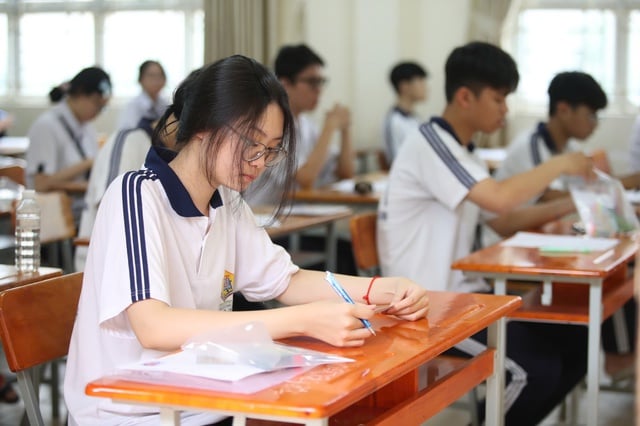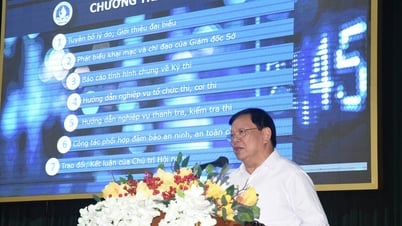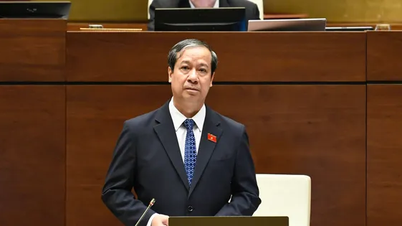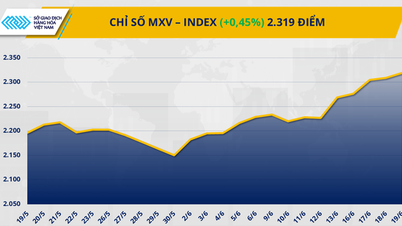The 1975 Baccalaureate Exam: A Post-War Miracle
After April 30, 1975, although the country was unified, theeducation systems of the two regions were not yet unified. In the South, the transition from the old educational model to the new socialist-oriented education model began. In that context, the baccalaureate exam in September 1975 had a special historical significance: it was the first high school graduation exam under the new regime, marking the transition between the two educational systems.

12th grade students in Ho Chi Minh City participate in the high school graduation mock exam. This is the first batch of candidates to take the graduation exam under the new general education program.
PHOTO: DAO NGOC THACH
Although it was held late, the exam still kept the name "baccalaureate" but was different in nature - it both ended the old system and opened a new education system. Hundreds of thousands of 12th graders in the South who had left their program when the country was unified returned to school to review for the exam. The exam was still based on the old program but had incorporated new content and ideas, especially in the subjects of literature, history, and geography.
Despite the lack of facilities and the small number of teachers, the exam was still held seriously and fairly, demonstrating the determination to put education as the foundation for national reconstruction. Many students after graduation continued to study, learn a trade or participate in production, contributing to the post-war recovery. The exam was organized by the coordination between the Ministry of Education of the North, the Ministry of Education of the Republic of South Vietnam and the former Examination Department staff, laying the foundation for national educational unification in the late 1970s.
Step by step changes in the goals and organization of the exam
Since the special exam in 1975, the high school graduation exam in Vietnam has undergone many large and small reforms, reflecting the continuous effort to ensure fair and effective assessment, reduce pressure on students and costs for society.
Period 1976 - 1980: The exam was organized independently from university admission. In the North, implementing the 10-year general education program, the high school graduation exam consisted of 4 subjects (math, literature and 2 subjects that changed annually). In the South, following the 12-year system, candidates took 4 subjects, including math, literature and 2 subjects according to the group. Group A took 4 subjects of math, literature, history, geography; group C took 4 subjects of math, literature, physics, chemistry; group D took 4 subjects of math, literature, chemistry and biology. The exam was chaired by the Department of Education and Training, for the purpose of graduation.
Period 1981 - 1998: 1981 marked the first national graduation exam, according to Decision No. 305-QD dated March 24, 1981 of the Ministry of Education. The exam subjects were not fixed in advance, depending on the actual teaching situation. According to the principle of studying each subject, taking the exam in that subject, the Ministry of Education annually stipulates which subjects are written exams, which subjects are oral exams, and which subjects are based on the average score of the final year report card as the exam score. The exam is chaired by the People's Committee of the province or city, with the goal of considering graduation.
Period 1998 - 2013: The official exam called "high school graduation exam" includes 6 subjects (math, literature, foreign language and 3 subjects according to the board). Of which, the Natural Sciences (KHTN) - Engineering board takes additional exams in physics, chemistry, biology; the Social Sciences (KHXH) - Humanities board takes additional exams in history, geography, philosophy. The exam is chaired by the Department of Education and Training, with the goal of graduation.
In 2007 and 2008, there was a second round of exams in August. 2007 was the first time the "two no's" policy (say no to negative exams and achievement problems in education) was applied. The first exam results in 2007 were only 70%, a record low, reflecting the tightening of discipline. The exam format was mainly essay-based, with multiple choice tests applied to some subjects such as foreign languages, physics, chemistry, and biology after 2002.

Candidates taking the 2024 high school graduation exam. In the 2020-2024 period, the exam will return to its proper function as a high school graduation exam. Universities will be autonomous in recruiting students and apply many methods.
Photo: Nhat Thinh
2014: Beginning of change in the spirit of the Resolution
29-NQ/TW, with the aim of reducing exam pressure. The exam has 4 subjects (math, literature required and 2 elective subjects). Foreign language is an option for the first time, but only about 20% of candidates register. The exam is organized by the Department of Education and Training, aiming to consider graduation.
Phase 2015 - 2016: The exam was renamed "National High School Exam", including 4 subjects: math, literature, foreign language and 1 elective subject. There were 2 exam clusters: the cluster hosted by universities (for graduation and university admission), the cluster organized by the Department of Education and Training (for graduation only). The graduation score included 50% of the average score of the final year report card.
In the 2017-2019 period , the national high school exam consisted of 4 tests: math, literature, foreign language and a combined test (natural sciences or social sciences), used for graduation and admission. The graduation score is calculated at 50% from the final grade point average. The exam was supervised and graded by the locality, in coordination with the university, but serious cheating occurred in 2018 in Ha Giang , Son La, and Hoa Binh.
In the period 2020 - 2024 , the exam will return to its proper function as a high school graduation exam. Universities will be autonomous in recruiting students, applying many methods: transcripts, competency assessment tests, interviews... The graduation score is only calculated at 30% from the transcript score. The annual graduation rate is 98 - 99%, showing that the exam is no longer as classifying as before.
From 2017 to 2024, the exam will be stable with 3 compulsory subjects and 3 elective subjects in the combination of Natural Sciences or Social Sciences. Thanks to the stability and improvement of teaching quality, the graduation rate will increase steadily, from 97.42% in 2017 to 99.4% in 2024. However, the rate of choosing the Social Sciences combination is increasing (from 43% to 63%), while the Natural Sciences combination is decreasing sharply (from 57% to 37%), contrary to the country's demand for science and technology human resources.

In 2025, the high school exam will have an important change, focusing on assessing capacity and qualities instead of just testing knowledge.
Photo: Dao Ngoc Thach
Expecting innovation from 2025
From 2025, when the first batch of students studying under the 2018 General Education Program graduate, the high school exam will have an important shift, focusing on assessing capacity and qualities instead of just testing knowledge. The exam includes 4 subjects: math, literature (compulsory) and 2 elective subjects in subjects such as foreign languages, physics, chemistry, biology, information technology, technology, history, geography, economic education - law. The graduation score is calculated from 50% of the three-year high school transcript, requiring students to study regularly and continuously from grade 10. In university admission, if using transcripts, there must be a score for the second semester of grade 12, encouraging students to study seriously until the end of the grade.
However, to approach international standards, the exam needs to be improved in three directions: organizing integrated interdisciplinary exams to assess thinking and problem solving; promoting digitalization, moving towards computer-based exams in qualified locations; and researching to allow some localities with the capacity to organize the exam themselves, including setting the questions. These changes aim to improve the quality, fairness and effectiveness of the high school exam in the period of educational innovation.
From the 1975 baccalaureate exam to the 2025 competency assessment exam is a 50-year journey of improving the high school graduation exam, reflecting the continuous innovation efforts of Vietnamese education. Each stage has its own advantages and disadvantages, but the common point is to focus on learners and training quality. If organized scientifically and with a clear roadmap, the high school graduation exam is not only an assessment tool but also a lever to improve the quality of education, effectively differentiate and stream students.
Lessons from the 1975 baccalaureate exam
The Baccalaureate exam in September 1975 took place in the post-war period, when the country was still facing many difficulties, material conditions were lacking, and people's lives were not stable. However, the education sector was still able to organize a serious, humane and flexible exam, thanks to the decisiveness of the leaders, the dedication of the teachers and the spirit of overcoming difficulties of the students.
The biggest lesson from this exam is that education needs to adapt quickly to social changes; exams are not only for assessment but also to affirm educational goals, to inspire belief in knowledge and fairness.
Source: https://thanhnien.vn/thi-tot-nghiep-thpt-nua-the-ky-cai-tien-va-doi-moi-185250619190326129.htm










































































































Comment (0)